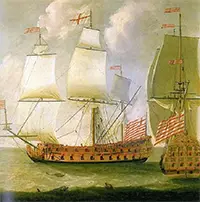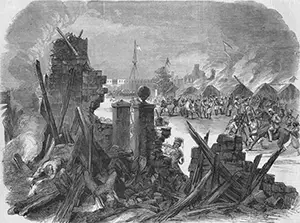The East India Company
The East India Company began as a trading venture in the 17th Century and ended as a governing body more than 200 years later. 
It was on the last day of the year 1600 that the East India Company (EIC) came into being, granted a royal charter by Queen Elizabeth I. Stockholders owned the company, and governing it were a governor and a board 24 directors. Four ships formed the first expedition, leaving in February 1601, and James Lancaster was the captain of the Red Dragon and the commander of the mission, which returned two years later with a very large cargo of pepper and the promise of much, much more–of all manner of other things as well. The "India" in the name of the company referred initially to the Indies, as in the East Indies. The Dutch East India Company had quite a handle on trade in that part of the world; and so English authorities, after enduring some years of failing to catch up to the Dutch revenue streams (not to mention fighting a series of wars), chose to focus on India itself. EIC representatives set up outposts on the Indian coasts; two of these were the future Calcutta and the future Madras. (The EIC later got control of the future Bombay as part of the marriage arrangement between Portugal's Catherine of Braganza and England's King Charles II.) The company soon had dozens of factories in various parts of India. Coming back to England from these places was a steady stream of a variety of goods, including cotton, indigo, opium, saltpeter, silk, silver, sugar, tea, and wool. To protect the trade, England installed security forces. 
In the 18th Century, the collapse of the Mughal Empire in India left a vacuum that was soon filled by foreign invaders. Neighboring lands like Afghanistan sent in raiding parties looking to expand their influence. The EIC, however, had the most difficulty with France, which had its own East India Company doing pretty much the same thing as the British were. French soldiers began indiscriminately seizing British trading posts. When the Seven Years War raged in Europe and in North America, it also involved fighting in India, between Great Britain and France. British forces led by Robert Clive won the Battle of Plassey in 1757 and ended French interference with the British India trade. In the late 1700s, Britain appointed to head up the company a series of governor-generals. Warren Hastings, the first to hold that position, set the standard for administration and infrastructure but was later impeached for questionable conduct. His successor was Lord Cornwallis, who streamlined business practices to a great degree. A subsequent governor-general, Richard Wellesley, oversaw a number of territorial acquisitions, achieved by either money or conquest. By the turn of the 19th Century, the EIC's private army was very large, twice the size of the British Army at that time. It wasn't just land forces, either. The EIC had its own navy, called the Bombay Marine. In 1833, the U.K. Parliament moved to solidify the company's hold on India, making it the Indian government in all but name. Courting controversy in the mid-19th Century was Governor-General Lord Dalhousie, who favored the "doctrine of lapse" as a means of gaining more assets for the East India Company. At the time, many Indians owned large swathes of land. The common practice was for a landowner to pass his land on to his heir(s). Dalhousie's "lapse" policy stipulated that if a landowner who died without an heir, then the EIC became the heir and took over the land. He made it even more effective by later preventing an heirless landowner from naming one. Also in the mid-19th Century occurred one of the most savage uprisings in the history of British occupation. The East India Company employed British and Indians as soldiers to defend the company's assets. The advancement of gun technology was such in the late 1850s that the EIC soldiers were using a new type of cartridge for their Enfield rifles. A soldier using such a gun would slide the cartridge down the barrel of the rifle in order to reload, and the cartridges were wrapped in grease-coated paper in order to make it easier to get the cartridge down the barrel. A rumor went around in 1857 that the grease that was used to coat the paper came from cows and pigs. The Indian soldiers were known as sepoys, and most of them were either Hindu or Muslim. Their religious beliefs prohibited them from touching such animals, and so if they had to handle the grease-coated paper that encased the rifle cartridges, then they would be touching cow or pig grease and so doing something that was against their religion. Making this rumor a bit more believable were the aggressive tactics of Christian missionaries, who had come to India in ever greater numbers, giving rise to yet another rumor, that the British intended to make India a Christian country. A large number of Indian soldiers refused to use the new cartridges and, in fact, took up arms against the British. This has become known as the Sepoy Rebellion; other names include the Sepoy Mutiny and the Indian Revolt of 1857. At that time, the number of sepoys in the British Army was about 300,000. The number of British in the British Army at that time was about 50,000. (Britain had pulled a large part of its Indian force away to fight in the Crimean War. 
The rebellion began with small acts of disobedience and escalated into large acts of violence. The sepoys marched to Delhi and took control of the city. The British responded with a three-month siege. Both sides committed unspeakable atrocities on prisoners and on the civilian population. Weakening the rebellion was the absence of the Indian aristocracy, which chose to sit on the sidelines. The British Government had had enough trouble with the EIC by this time. The Government of India Act 1858 supplanted the EIC with the British Government itself. This was the beginning of the British Raj. Parliament disbanded the EIC entirely in 1874. The EIC had its own flag, which changed through the years. The appearance of the flag mirrored the changes taking place in the homeland. The initial flag featured the St. George's Cross of the Kingdom of England, the next was the Union Flag (adding a St. Andrew's Cross to signify Scotland) that came about as a result of the Act of Union 1707, and the last was the U.K. flag, which added a St. Patrick's Saltire and was the result of the Act of Union 1800. |
|
Social Studies for Kids
copyright 2002–2024
David White




